Professor Isabel Pérez-Otaño Receives Prestigious $1 Million Grant from USA National Multiple Sclerosis Society
18 de September de 2024
- Multiple sclerosis is a disease of the brain and spinal cord caused by the loss of myelin. It affects more than 2.8 million people worldwide.
- The team led by Professor Pérez-Otaño at the Institute for Neurosciences has discovered a brain receptor that could unlock myelin plasticity.
 The National Multiple Sclerosis Society (USA) has awarded a grant of 1 million dollars to Dr. Isabel Pérez-Otaño, who leads the Plasticity and Remodeling of Neural Circuits laboratory at the Institute for Neurosciences (IN), a joint center of the Spanish National Research Council (CSIC) and the Miguel Hernández University (UMH) of Elche. The grant is part of the NMSS 'Pathways to Cure' program that funds innovative therapeutic approaches to treat multiple sclerosis (MS). The team will work on identifying mechanisms that mediate a special kind of brain plasticity, known as myelin plasticity. The goal is to find ways to stimulate myelin plasticity to regenerate affected nerve fibers in MS patients.
The National Multiple Sclerosis Society (USA) has awarded a grant of 1 million dollars to Dr. Isabel Pérez-Otaño, who leads the Plasticity and Remodeling of Neural Circuits laboratory at the Institute for Neurosciences (IN), a joint center of the Spanish National Research Council (CSIC) and the Miguel Hernández University (UMH) of Elche. The grant is part of the NMSS 'Pathways to Cure' program that funds innovative therapeutic approaches to treat multiple sclerosis (MS). The team will work on identifying mechanisms that mediate a special kind of brain plasticity, known as myelin plasticity. The goal is to find ways to stimulate myelin plasticity to regenerate affected nerve fibers in MS patients.
(Photo: Isabel Pérez Otaño, CSIC Professor at the Institute for Neurosciences CSIC-UMH)
MS is a chronic neurological condition that affects the central nervous system. It is caused by the destruction of myelin, a protective sheath that insulates nerve fibers and ensures rapid, efficient communication between neurons. When myelin is damaged, the flow of information between the brain and the rest of the body is disrupted, leading to a wide range of debilitating symptoms. These can include vision impairment, loss of coordination, difficulty walking, and cognitive challenges such as memory loss and trouble concentrating.
Studies suggest that MS has an autoimmune origin. While advances have been made in halting the immune system’s attack on oligodendrocytes—the cells that produce myelin—current treatments lose efficacy as the disease progresses. At present, no therapies exist that can restore lost or damaged myelin. “Our brains have an inherent repair mechanism called remyelination, which is activated after damage to form new myelin sheaths. But this repair capacity fails with age and disease progression, leading to irreversible disability,” explains Pérez-Otaño.

(Photo: Remy Verhaeghe, Isabel Pérez-Otaño, Ana Isabel Navarro Navarro, Moumita Chatterjee and Alice Staffa, IN-CSIC-UMH researchers)
Pérez-Otaño’s research brings renewed hopeI. Oligodendrocyte progenitor cells (OPCs) are abundant in the brain and spinal cord of MS patients, and offer an unmatched opportunity for generating new oligodendrocytes and promoting myelin repair. The challenge is to find ways to enhance their responses and improve their ability to form myelin.
The team led by the researcher at the IN has discovered a brain receptor that could help activate these stem cells and unlock the plasticity of myelin. The research will focus on developing gene therapy or pharmacological approaches and test their ability to bring back efficient myelination in mouse models. Additionally, the team is exploring the potential of combining gene therapy with pharmacological treatments and rehabilitation strategies to further enhance myelin repair after injury.
The project will be done in collaboration with international leading experts in the field, including Professor Thora Karadottir at the Cambridge Center for Myelin Repair (UK), Professor Anna Williams at the University of Edinburgh (UK), and researcher Juan Antonio García León from the University of Málaga (Spain). All bring wold-class expertise in myelin repair and the study of human MS patients. A breakthrough from this research could not only transform the treatment landscape for MS but may also have wide-ranging implications for other neurodegenerative diseases, such as Alzheimer´s or Huntington´s disease, where myelin failure has been implicated.
You can collaborate with the National Multiple Sclerosis Society (USA) at the following link:
https://donate.nationalmssociety.org/index.cfm?fuseaction=cms.page&id=8508&&donate=529
Source: Institute for Neurosciences CSIC-UMH (in.comunicacion@umh.es)

 Español
Español